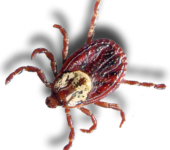Sleigh bells ring, are you listening? In our yards, ticks are missing…
Wow, can you believe that December is here already? Time to break out the Christmas records, put up the holiday lights, and dust off the warm winter jacket (preferably orange, if possible) before the temperatures drop to teeth-chattering levels here in Canada.
While each of these DIY tasks are important in their own way, there is one winter assignment that we at Alternative Earthcare value over all others: tick-proofing your property. Because while some pests do die out in the winter due to the onset of colder weather, ticks are unfortunately not one of them. Bah humbug, we say!
While ticks are much less prevalent and pose less of a threat to you or your pets in winter than they would in, say, spring and fall, you should still keep an eye out for those pesky arachnids during the colder months, especially if you live near heavily-wooded areas with large populations of deer, rabbits or mice. If certain factors exist, it is possible for ticks to be active and latch on to someone or something when looking for a warm place to hide…
Read on to learn more about what happens to ticks in the winter.
Do Ticks Die In The Winter?
The simple answer? Unfortunately not. Depending on the species and life cycle of the tick, they will become dormant or latch on to their host – like a warm-blooded human, pet or deer – when temperatures drop in their environment, instead of just dying outright. The warm skin and fur of an animal host can provide a tick with protection from the cold and the necessary energy to outlast a cold winter. This is what a tick spends most of its fall quest trying to accomplish; finding a rent-free host for winter.
Ticks can also be active in the winter, if the winter is mild and there is not much snow. Thankfully, that’s usually not an issue here in Long Island.
Protect Your Property
Just like us humans, ticks are all about staying warm in the winter months. To do so, they will hide in leafy or wooden areas (if they can’t find a warm-blooded host or are in the nymph stage) where they can escape the harsher temperatures, and when snow falls, will bury themselves in debris or whatever else they can find in their environment. These could include leaf piles, wood/mulch piles, and overturned pieces of wood or plastic on your property. Thankfully, though, there a number of preventative measures you can take to help minimize the risks of ticks around your home in winter, especially if unexpected warm spells occur. These include:
- Keep tall grasses mowed
- Keep vegetation trimmed
- Get rid of any leaf litter or weeds at the edge of your lawn
- Remove brush and leaves around stone walls or wood piles
- Move wood piles away from the house
- Check the weather before going for a hike with pets
- Keep your pets and kids out of the woods to avoid bringing ticks back to your home
- Move kids swings or sandboxes away from the woodland edge
- Wash clothes in hot water if you’ve just come back from a tick-ridden area
- Use a professional tick control service to eliminate the risk of ticks











